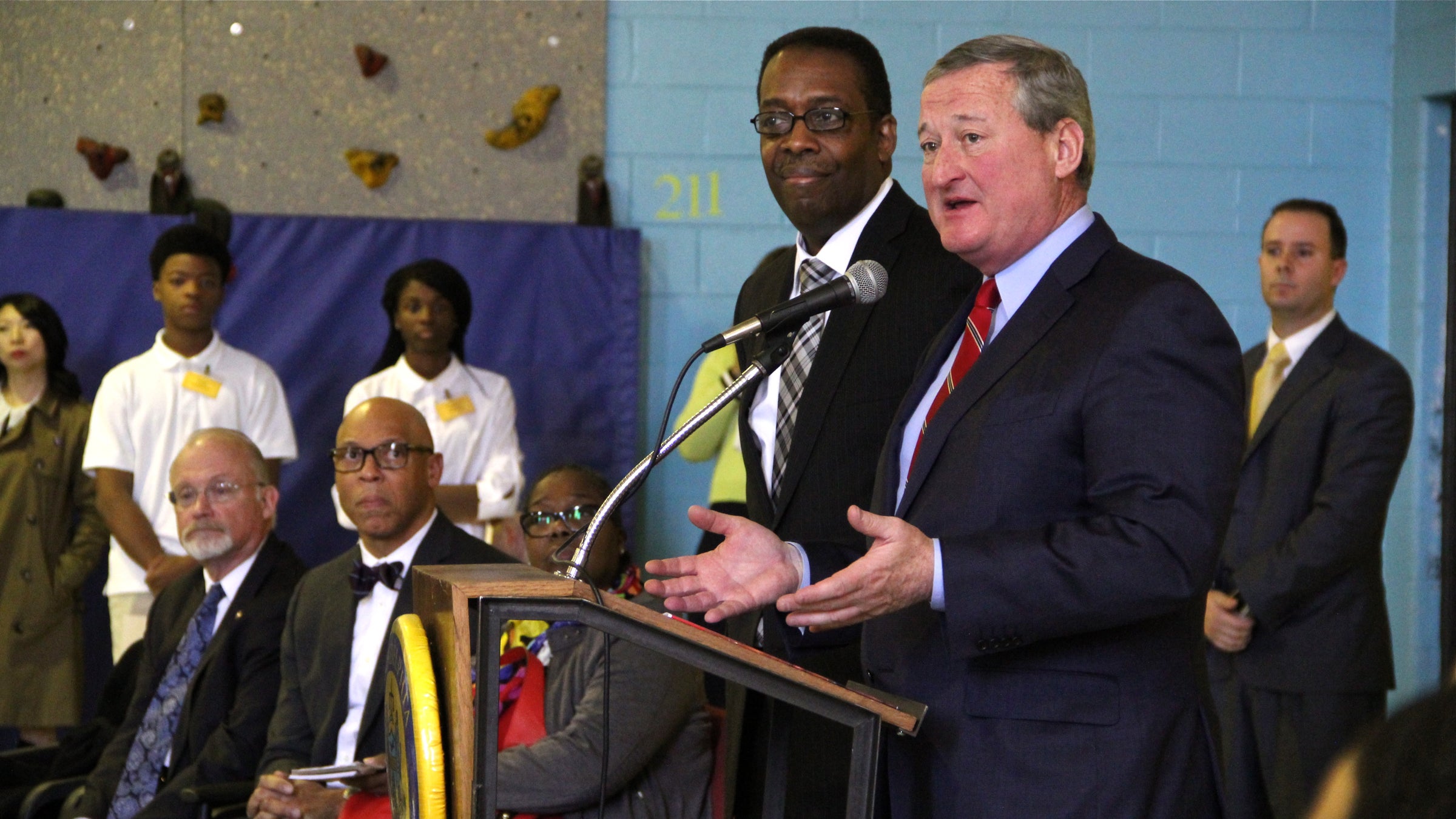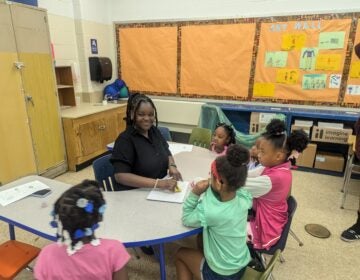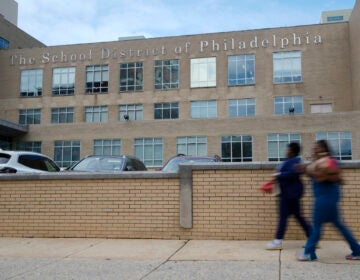Mayor-elect Kenney pushes plan to create 25 community schools
Listen
Council President Darrell Clarke and Mayor-elect Jim Kenney convene at Duckrey Tanner School to share what they learned during a fact-finding trip to Cincinnati. (Emma Lee/WHYY)
In his first major policy announcement since winning election, Philadelphia Mayor-elect Jim Kenney formalized a campaign promise to create 25 “community schools” over the next four years.
Before a sea of schoolchildren and television cameras in the gymnasium of North Philadelphia’s Tanner Duckrey Elementary, Kenney told students Monday that the initiative would help give them “the ability to reach your potential in your life.”
The event comes on the heels of Kenney’s trip to Cincinnati last week, where he and Council President Darrell Clarke took a first-hand look at a district that’s prioritized a community school model that includes health and social services in neighborhood schools.
Kenney and Clarke aim to replicate that model in Philadelphia, creating “school-based family service centers.” They envision schools as hubs of health care – with access to primary care physicians, vision and dental services, as well as behavioral health and counseling supports.
These schools would also offer child care and after-school services.
Kenney says his goal is achievable with a relatively small investment – estimating an $8 million annual price tag.
“We deliver services every day from the City of Philadelphia through our operating budget. What we’re talking about is repurposing those services into school-based models so that we can listen to the principals and teachers, so they can let us know what they know about their schools and what services they need,” said Kenney.
Clarke, saying community schools would make “a much better city of Philadelphia,” explained that there’s already a working model of this plan evident in the city every day.
“You’re maybe scratching your head, ‘What schools are they?’ Well guess what? They’re not schools. They’re prisons,” said Clarke. “And damn it, you can’t tell me we can deliver those services in prison and we can’t have these types of services in a school, in a building for these young people. You can’t tell me that.”
Kenney and Clarke say they plan to implement the model by leveraging resources from private interests as well as leaning on the city’s universities to provide support.
“You’re going to hear some good things about that very soon,” said Clarke, whose office said it could not yet provide details. “Everybody is on board for this.”
Joining the pair at Monday’s presser were School District of Philadelphia Superintendent William Hite, School Reform Commission Chair Marjorie Neff, SRC member Sylvia Simms, Philadelphia Federation of Teachers President Jerry Jordan, as well as Otis Hackney, the principal of South Philadelphia High School recently tapped to become Kenney’s chief education officer.
Academic difference?
Kenney believes implementation of the community school model will do more than improve the health and well-being of children. He believes it will drive increased academic results.
“If a child can read, if a child isn’t hungry, if a child isn’t emotionally traumatized, if there are support systems within the school where he goes or she goes every day, the academic performance has to go up,” Kenney said in an interview after the event. “Why would it stay the same or go down?”
“If kids are living in terrible conditions and terrible situations, and we’re not doing anything to alleviate that holistically, then no, they’re not going to do well,” he continued.
So what evidence is there that community schools drive student successes in reading, writing and mathematics?
City Council’s report on school-based family service centers highlights the fact that, in the 16 years since implementing its first community school, Cincinnati has become the highest performing urban district in Ohio while narrowing the achievement gap and boosting the graduation rate.
But it’s necessary to take a deeper view.
Cincinnati took out a $1 billion capital bond to fund the creation and expansion of community school buildings. The city has also seen generous support from its corporations and hospitals. Despite these investments, only the Oyler School – the one Kenney and Clarke visited – has been able to offer the full complement of community school services.
In a yearlong look at Oyler, American Public Media’s Marketplace found that the school has continued to face a mountain of struggles.
After initial positive momentum, test scores have declined in recent years. The school failed to meet the Ohio’s minimum for student attendance in 2013-14. And only about 50 percent of its ninth-graders are finishing high school in four years.
On Ohio’s school quality ratings scale, Oyler received all D’s and F’s
As New York City Mayor Bill de Blasio campaigned, in part, on the promise of learning from Cincinnati’s community schools model, a 2013 New York Times analysis found that the schools “are still in dire academic straits … despite millions of dollars in investment and years of reform efforts.”
A 2009 study by the National Bureau of Economic Research of the Harlem Children’s Zone – which offers a combination of community-based investments with charter schools – found that emphasis on co-locating supports would not alone drive academic results.
The jury, though, is still out. A 2014 study by Child Trends found that schools with integrated student supports deflated drop-out rates while boosting attendance and performance measures.
Optimism abounds
Philadelphia’s political and educational leaders remain enthusiastic.
In an interview after the event, Hite said community schools would provide needed relief to educators who have been often tasked with wearing many hats in the wake of devastating funding shortfalls.
“If in fact we can get many of these services into schools in a coordinated way, then we can begin focusing on teaching young people to read,” said Hite.
Hite recently announced his desire to turn three low-performing elementary schools into neighborhood-based charters. Some parents in those communities have expressed a wish to instead opt for the community school model. On Monday, Hite reiterated his hope for Cooke, Wister and Huey elementaries to undergo charter conversion.
Hackney said the push for community schools should be seen as one star in a grander constellation.
“It’s not the single answer,” he said. “It’s just one aspect of the things that should happen in school.”
As principal of South Philadelphia High School, Hackney is credited with creating community partnerships from the bottom up that have helped resurrect the school’s reputation. As he directs Kenney’s community schools vision, he says he’ll continue that work.
“If you have people dedicated to supporting the children and the community, and really have open eyes and ears for what the community is asking, you’ve just built a model of high expectations and high support,” he said. “And that’s what this is all about.”
The City Council report boasts Sayre High School as the city school that currently comes closest to the community school model Kenney and Clarke envision.
Through a partnership with the University of Pennsylvania, Sayre began keeping its doors open until 8 p.m. It offers free after-school mentoring and has added an in-house health center where students and community members have access to Penn doctors.
Despite these added supports, Sayre has not become a leader in academic performance – even among schools serving a similar student population.
The Philadelphia School District’s school quality metric ranks Sayre 18 of 27 among its peer group. The district’s School Progress Report gives Sayre “intervene” ratings, its lowest, for achievement, climate, and college and career readiness.
The City Council brief quotes a study from the Annenberg Institute for School Reform saying that Sayre’s graduation rate is 90 percent. Not disclosed is the fact that that study was published in 2011.
According to the Pennsylvania Department of Education, Sayre’s 2014-15 graduation rate was 61.7 percent.
South Philadelphia High School – where Hackney is still principal – also rates low among its peers on the SPR.
But the graduation rate at Southern has climbed more than 30 percentage points under Hackney’s watch, to nearly 70 percent – a stat Kenney emphasized.
As for the other concerns?
“Look, there’s plenty of skepticism around,” the mayor-elect said as he walked out of Duckrey’s gymnasium. “We have all the skepticism we need.”
WHYY is your source for fact-based, in-depth journalism and information. As a nonprofit organization, we rely on financial support from readers like you. Please give today.





